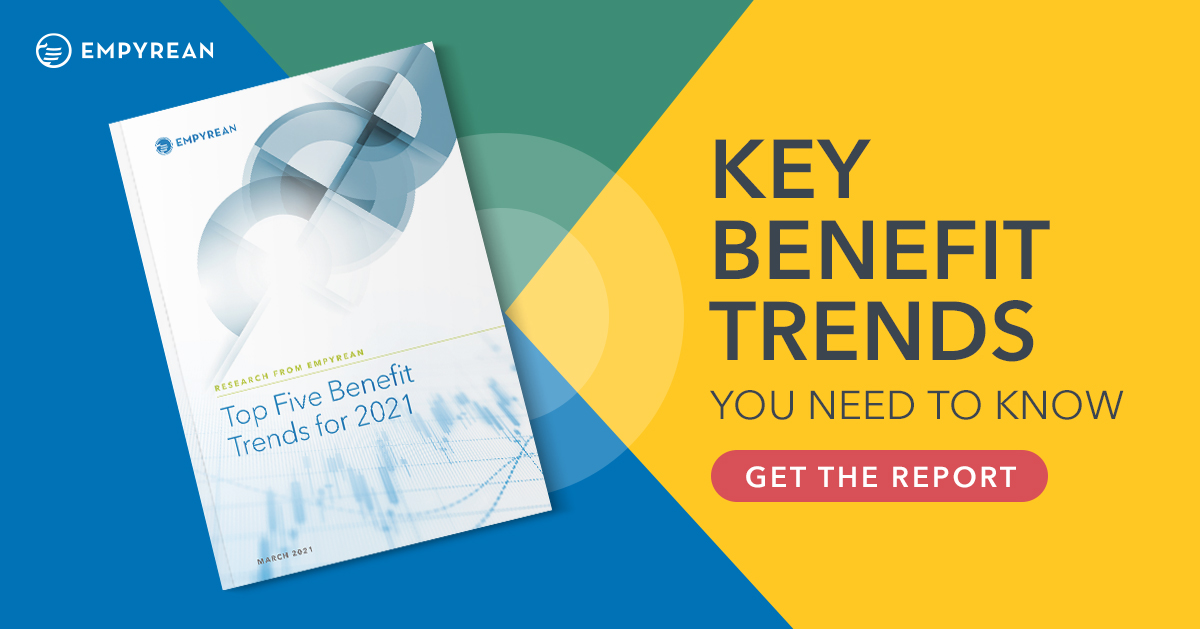New Empyrean Research: 5 Benefits Trends to Watch in 2021
The pandemic has changed the workplace forever, creating seismic shifts in the way employees measure and interact with their benefit programs and offerings.
Employers have been forced to view benefits and their resulting employee impact through a new lens, requiring organizations to adopt new strategies and approaches to support their employees’ evolving physical, mental, and financial health needs. Benefits like remote work stipends, expanded mental health and financial wellness resources, and virtual decision support have become essential components of a comprehensive employee benefits program.
Empyrean’s latest research report, “The Top 5 Benefits Trends for 2021,” summarizes the results from our annual client survey and provides fresh insights to help your organization build a forward-thinking employee benefits strategy. We have outlined some of the key highlights below, but to view the full report, you can download your copy here.
1. COVID-19 has made a clear and lasting impact on employee benefit expectations and offerings
Throughout the pandemic, employee benefits took center stage as one of the most critical and impactful ways to support what quickly became overtaxed and overstressed workforces. Results from our client survey reveal that once COVID-19 hit, employers quickly took action to provide enhanced benefits to support their employee populations. For many, this came in the form of special benefits enrollment periods or additional contributions to employee health savings accounts (HSAs).
As the pandemic continued, many employers have gone a step further, providing employees with additional resources and tools to support total wellness. Telehealth benefits have grown in popularity, and mental health counseling, doctor visits, and physical therapy conducted via video chat technology have become more commonplace, improving accessibility to providers and reducing the time needed to access this type of support.
As our report explains in further detail, virtual benefits are poised to become a more prominent fixture in plans moving forward, and employees are expected to continue to expect (and demand) these types of programs.
2. Employers are leaning on voluntary benefits to support total employee wellness
While medical and retirement benefits provide a solid foundation for employees and their families, voluntary benefits address a broader range of physical, mental, and financial wellness needs.
Whether employees are looking for a better work-life balance, financial planning support, or new ways to cope with the stress of working from home, voluntary benefits can round out traditional benefit programs and support the whole employee. Some of the available voluntary benefits discussed in our report include:
- Expanded mental health benefits, including employee assistance programs (EAPs)
- Personalized tools to support financial planning and savings
- Workplace programs designed to offer greater flexibility
Supplemental benefits can help ensure that the holistic needs of diverse employee populations can be met.
3. Integrated benefits technology and predictive analytics will be relied upon to efficiently manage rising benefit costs
One of the perennial employee benefit challenges faced by HR, total rewards, and benefit leaders is balancing rising costs with the need to offer comprehensive and competitive benefits to not only support employees, but to attract and retain talent. By taking advantage of new advancements in benefits management technology and predictive analytics, employers can better understand benefit costs and anticipate future expenditures with greater accuracy.
As described in our report, benefits technology delivers dynamic reporting to support the budgeting process, as well as analytics to track key benefit metrics for your organization. As a result, you can take a more proactive approach to benefits spending, selection, and overall decision-making.
4. Decision support tools will be more frequently used to educate, advise, and engage employees
In a 2021 Voya consumer survey, one-third of respondents reported that they did not fully understand any of the employee benefits they enrolled in during their most recent open enrollment period. Despite materials and support available during open enrollment and throughout the year, many employees lack a full understanding of their benefit coverage and how to make cost-effective selections that are sized appropriately for their unique needs.
In an effort to better educate employees about their benefit options, benefits decision support technology has grown in popularity. As explained in our report, decision support utilizes AI and data analysis to generate recommendations tailored to each unique employee, enabling employees to better select (and then utilize) right-sized coverage for both themselves and their families.
5. Increased employer focus on continued benefits regulatory compliance developments
The past year has seen no shortage of new regulations affecting employer benefit programs and offerings. And while Empyrean’s experts say that compliance shifts are nothing new, the sheer number and complexity of new compliance changes and regulatory rollouts have employers paying attention.
The COVID-19 pandemic has been a major driver of new legislation in the employee benefits space, as most recently seen with the American Rescue Plan Act and the 100 percent paid COBRA subsidy provision.
The continued pandemic and the anticipated actions of a new White House administration are expected to result in more legislative change. As highlighted in our report, employers anticipate the need to lean on benefit administration partners to navigate the evolving regulatory compliance landscape of 2021 and beyond.
What else is in store for 2021?
This year’s research report highlights the indelible mark the pandemic has had on employee benefit offerings and go-forward strategies. With a stronger understanding of this year’s benefit trends, your organization can stay informed about the many options available to assist you in meeting your employees’ evolving needs and expectations.
For additional data and insights tied to this year’s benefit trends, download your copy of the 2021 Benefit Trends Report today.
